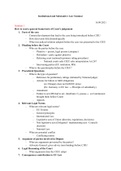Class notes
Institutional and Substantive Law Seminar Notes
- Course
- Institution
This pdf contains all of the seminar notes, including case notes, taken during the first part of the Institutional and Substantive EU Law Course, being Institutional EU Law.
[Show more]




